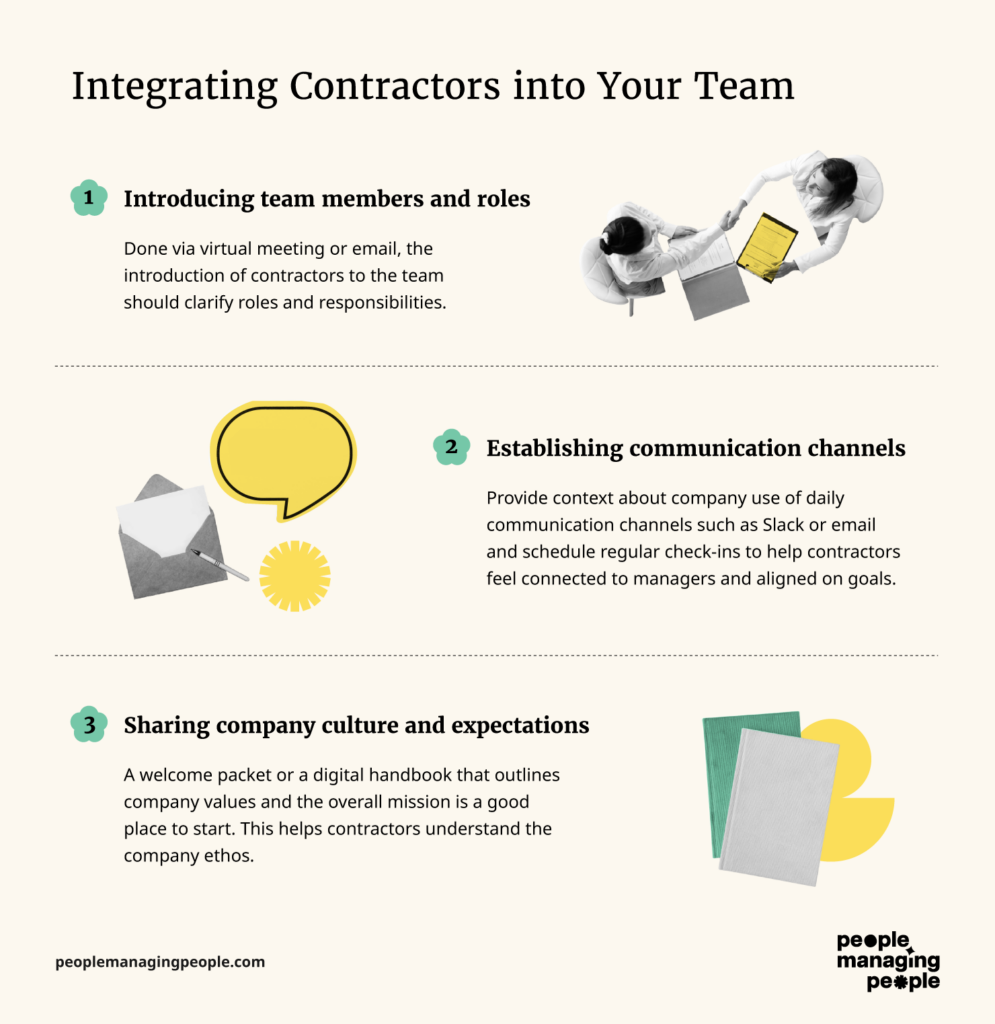Onboarding independent contractors is as important as onboarding any other employee. But the contractor onboarding process is a little different and demands different actions than what you would do for a typical employee.
A structured onboarding process will ensure clarity, completeness, and efficiency. The goal is to achieve seamless contractor onboarding by involving necessary stakeholders early on and ensuring compliance with company policies and guidelines.
In this article, we’ll take you through the steps to creating an effective independent contractor onboarding and help you build a contractor onboarding checklist.
The Importance of Onboarding Independent Contractors
Effective onboarding of independent contractors can help address a variety of common concerns when it comes to working with a contractor. If you’re working with an employer of record, they may be able to drive better results for your contractor onboarding.
This includes things like:
- Compliance
- Boosting productivity
- Building strong working relationships
- Creating a consistent experience.
Proper onboarding helps contractors understand their roles, aligns them with your company’s goals, and ensures they have the tools and information needed to succeed from day one.
Legal and Compliance Considerations
As you put a contractor agreement in place, you will have to collect all necessary legal documents. It’s best to make a checklist of these relevant to the contractor’s local and national laws as well as those of the business.
As you gather and securely store contractor details, refreshing your knowledge of relevant privacy laws and communicating company policies with the contractor can keep you out of any legal trouble when it comes to regulations such as Europe’s General Data Protection Regulation (GDPR) rules.
There’s a variety of legal and compliance matters to address in clear language in your contractor agreements. In it, you should also outline clear expectations for the role and set terms around things like intellectual property, payment schedule, company policies and the contractor's scope of work.
Classifying Contractors vs. Employees
Misclassifying employees as independent contractors can lead to significant penalties.
According to the IRS, businesses must consider behavioral control, financial control, and the type of relationship when determining a worker's status.
Proper classification of contractors vs employees ensurescompliance with labor laws and tax regulations, protecting your company from fines and legal action.
Contracts and Agreements
Contracts for independent contractors should clearly define the scope of work, payment terms, confidentiality, and non-compete clauses.
If you’re creating a variety of contract types or using a contract across a wide range of roles, a contract management software could become a highly valuable tool to simplify this work.
For example, a contract might state that a graphic designer will create five pieces of marketing material per month, with payments issued bi-weekly upon receipt of an invoice. Including these details helps manage expectations and provides legal protection for both parties.
Tax Documentation
In the U.S., independent contractors must complete a W-9 form, which provides necessary tax information. Your company will need to issue a 1099-NEC form at the end of the year for tax reporting purposes.
Ensuring accurate and timely tax documentation helps avoid complications during tax season and ensures compliance with IRS requirements.
How To Handle Independent Contractor Onboarding
Once you decide to move forward with a contractor, the actual onboarding process needs to be tailored to suit the contractor relationship. The level of support and engagement required from the contractor should be aligned with the scope and regularity of work they’ll be doing with the company.
Here are some common steps to follow as you begin to onboard a new contractor.
Collect Necessary Information
Gather essential information and documents from contractors, such as identification, contact details, banking information for payments, and capturing payment details in an onboarding form.
Collect the necessary tax forms for onboarding compliance and record-keeping and file the information in your contractor payroll system to ensure smooth administrative processing and payment setups.
Related read: How to Solve Common Contractor Payroll Issues
Set Up Payment Systems
Payment systems and schedules may vary from one contractor to the next, especially if you’re paying international contractors.
During a new contractor’s onboarding make sure the payroll team is updated with necessary payment details, including the preferred payment methods, such as direct deposit, crypto currency or online payment platforms.
Outline the invoicing process, specifying when and how invoices should be submitted by the contractor. For instance, you might require invoices to be submitted by the 25th of each month for payment by the 1st.
Provide Access to Tools and Systems
Grant contractors access to necessary tools, software, and systems. This may include project management software like Asana or Trello, communication platforms like Slack, and any specific tools related to their work.
Ensuring they have access to these resources from the start enables them to hit the ground running.
Integrating Contractors Into Your Team
As you move through your 30, 60, 90 day programming, it becomes increasingly important that contractors find a rhythm in their work with the teams and managers they report to.
To ensure this process goes smoothly we've outlined a few ways you can help them along in the graphic below.

Training and Development
Initial training and orientation to get contractors up to speed should include sessions on the following:
- Company-specific software
- Overview of processes
- Introductions to key team members.
The goal is to create the foundation for successful collaboration.
Evaluating Contractor Performance
You want to establish performance metrics and KPIs for contractors, just like any other employee even though the metrics might be a little different.
For example, you might set goals for project completion times, quality of work scores, and adherence to deadlines.
Clear metrics provide a basis for evaluating performance and ensuring contractors meet your standards.
Conducting Performance Reviews
Conduct regular performance reviews to provide constructive feedback. These reviews can be quarterly or bi-annually, depending on the length and scope of the contract.
Discuss achievements, areas for improvement, and set goals for future performance.
Addressing Issues and Concerns
If a contractor’s performance is lacking, have a candid discussion to identify the root cause and develop a plan for improvement if you believe they add value to the business and would like to continue working with them.
At the end of the day, one of the benefits of working with contractors is the ability to continuously reassess the need to work with them and to end the relationship in a natural, clean manner as opposed to conducting a layoff.
Best Practices For A Smooth Onboarding Process
The most important thing that you’ll need to do when developing a customized onboarding process for a contractor is to create an onboarding checklist that takes inspiration from your more standardized onboarding processes for employees.
Beyond your checklist, here are a couple other things to keep in mind.
Leverage technology and services for onboarding
Use tools and software to streamline the onboarding process. Platforms like Gusto for payroll and HR, DocuSign for contracts, and Trello for task management can simplify administrative tasks and improve efficiency.
There are tools designed specifically to help you with this, from onboarding software to performance management tools.
If you’re working with a reputable employer of record or global HR service, they should also be able to help you with onboarding tasks as well.
Deciding to go with a software or a service provider, many of which use leading software tools, is a decision that will have to be made based on budget, what HR services you want to outsource and frequency of need.
Create a path for continuous improvement
Continuously improve the onboarding process based on feedback and changing needs. Regularly solicit feedback from contractors about their onboarding experience and make adjustments as necessary.
Things are always changing and as the number of independent contractors grows, regulations around health benefits and pay are shifting as fast as the competitive landscape for hiring.
Key Takeaways
- Effective onboarding of independent contractors ensures clarity, compliance, and efficiency. This structured process helps contractors understand their roles, aligns them with company goals, and provides the tools and information needed to succeed from day one.
- Contractor onboarding involves gathering necessary legal documents, ensuring compliance with privacy laws, and clearly outlining expectations in contractor agreements. This helps prevent legal issues and protects both the company and the contractor.
- Onboarding should include introducing contractors to team members, establishing communication channels, and sharing company culture. Additionally, setting performance metrics and conducting regular reviews ensures contractors meet standards and contribute effectively to the business.
Want to keep up with the latest trends and best practices around employing independent contractors? Sign up for the People Managing People newsletter to get all the latest insights from recruitment and employee experience experts.



